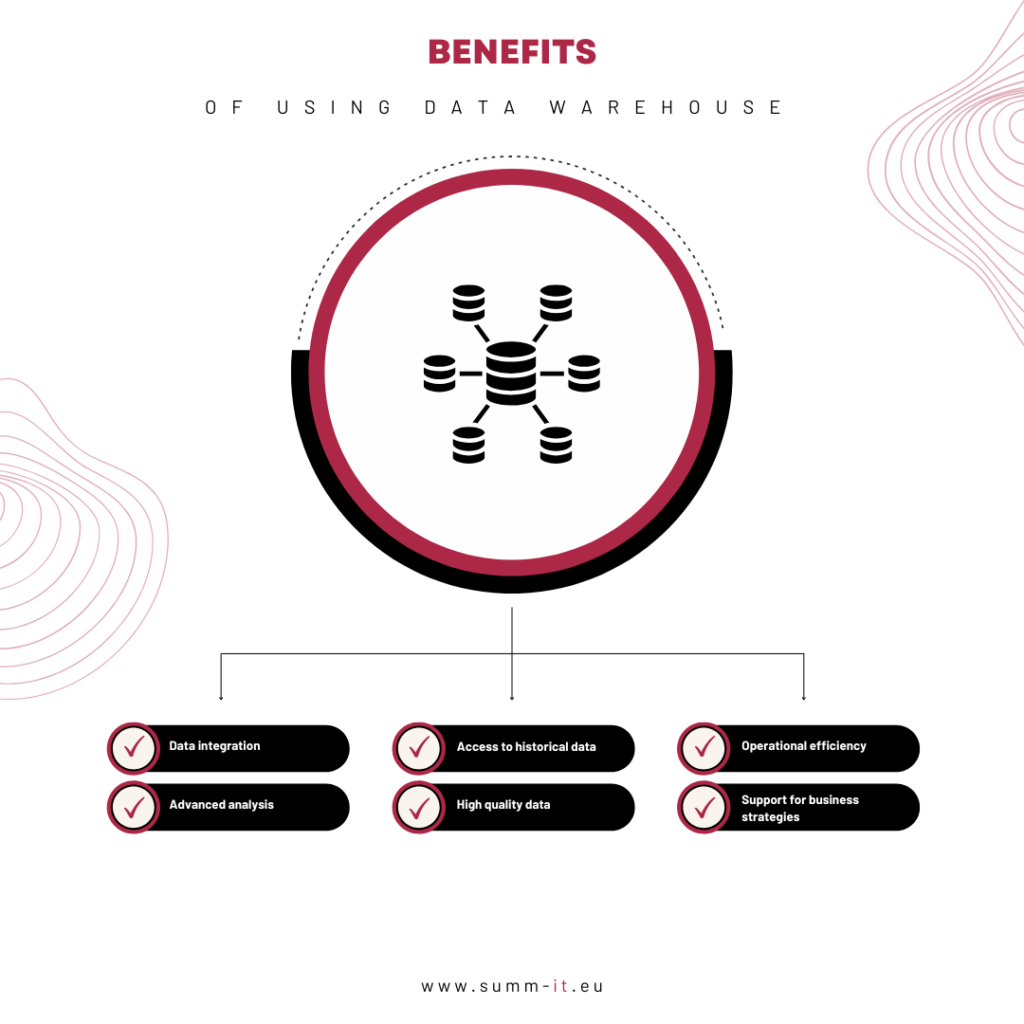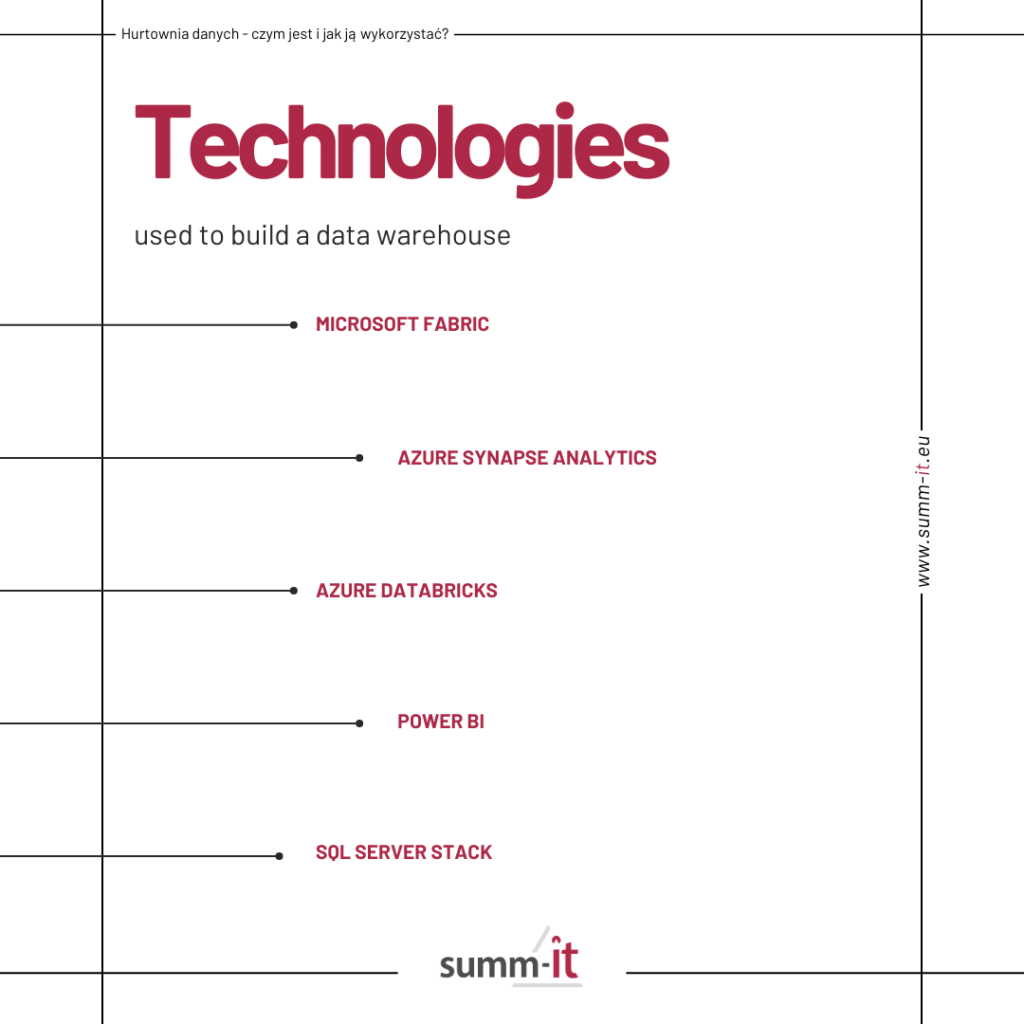Data warehouse – what is it and how to use it?
28 January 2025
Reading time: 13 minutes

In today’s fast-paced world, data has become one of the most valuable resources of any organization. Data warehouses play a key role in collecting, storing and analyzing vast amounts of information. They enable companies to make more informed decisions, optimize business processes and anticipate future trends. In this article, we will take a closer look at the concept of data warehousing, answer such questions as: what is a data warehouse, what is the difference between a data warehouse and a database, what are its benefits, and what is the process of creating a data warehouse.
Definition and explanation of a data warehouse
A data warehouse is a sophisticated information system that enables the collection, storage and analysis of huge amounts of data from various sources. This allows companies to integrate data from different departments, such as sales, marketing or logistics, in one central location. Data warehouses are designed to support analytical and reporting processes, allowing information to be processed quickly and efficiently. As a result, companies can make more informed business decisions based on comprehensive and up-to-date data. These types of solutions are invaluable in today’s world, where access to accurate information is crucial to staying competitive in the marketplace.
The difference between a data warehouse and a database

- Target
Database: Stores operational data that is used on a daily basis in company operations.
Data Warehouse: Enables data analysis and reporting, supporting decision-making processes
within the company.
- Data structure:
Database: Data is stored structurally, using tables and relationships between them.
Data warehouse: Data is stored in an integrated manner, meaning that it is stored in one place without excessive separation into different tables.
- Data sources:
Database: Stores data primarily from a single system or application.
Data warehouse: Collects data from various sources, such as CRM systems, ERP, websites.
- Data processing:
Database: Uses online transactional processing (OLTP), which is optimized for fast data operations.
Data warehouse: Uses online analytical processing (OLAP), which is tailored to analyze large amounts of data.
- Application:
Database: Is used to store and manage operational data.
Data warehouse: It is used to examine past data and support business decision-making.
Examples of the benefits of using a data warehouse
Data warehouses bring a number of benefits that can greatly improve business operations. First of all, they allow you to gather data from various sources in one place, which gives you a complete picture of the company’s situation. This makes it possible to conduct advanced analyses that support business decision-making. Distinctions include:

- Data integration: Combining data from different sources in one place, providing a consistent and unified view of the organization’s overall data.
- Advanced analytics: The ability to perform complex analysis to support business decision-making processes.
- Access to historical data: Enabling trend analysis and forecasting of future events based on past data.
- High data quality: Data cleansing and transformation processes ensure high quality and consistency of stored information.
- Operational efficiency: Faster access to data and the ability to process it easily, which speeds up operational activities.
- Support for business strategies: For example, a sales company can compare sales data across channels to help develop effective market strategies.
Technologies used to build data warehouses
Building a data warehouse requires advanced technologies that enable efficient management and analysis of large data sets. Among the most popular solutions are:

- Microsoft Fabric: enables you to design, build and maintain data infrastructures, process large volumes of data, and derive valuable analysis and insights.
- Azure Synapse Analytics: allows you to integrate, explore, prepare, manage and analyze data to get detailed, real-time insights.
- Azure Databricks: integrates with other Azure services, allowing you to easily scale and manage data and perform advanced analytics and machine learning.
- Power BI: integrates with a variety of data sources, including data warehouses, allowing you to easily analyze and present data in an accessible way.
- SQL Server Stack: allows you to store, manage and analyze data, as well as integration with other analytics tools, such as Power BI and Azure Synapse.
Each of these technologies offers unique features that support the processes of integration, processing and visualization of data.
Steps in the process of creating a data warehouse
All steps in the process of creating a data warehouse are extremely important, as they ensure that the system will run smoothly and meet the organization’s requirements. By carefully carrying out each of these stages, you can ensure high quality, consistency and availability of data. In addition, well-planned and executed stages minimize the risk of errors and technical problems, which will result in a more efficient and reliable data warehouse.

Overview of the steps in the process of creating a data warehouse
Such a process consists of several key steps that ensure effective data management and analysis.
- Planning: Determine the goals, requirements and resources needed to create a data warehouse.
- Design: Creating a detailed system design, including data architecture, database schemas and indexing strategies.
- Implementation: Executing the project through coding, systems configuration, and integration of tools and technologies.
- Testing: Conducting tests to verify system correctness, data quality and performance.
- Deployment: Launching the data warehouse and making it available to end users, including staff training.
- Maintenance: Monitoring and managing the system to ensure its continued performance and availability.
- Support: Providing technical support and resolving problems that may arise during the use of the data warehouse.
Planning
Planning is the first and very important stage in the process of creating a data warehouse. At this stage, the goals and business requirements that the data warehouse is to meet are defined. It is crucial to understand what information is needed for decision-making and what questions will be asked of the data. Based on this information, the scope of the project is defined, data sources are identified, and appropriate technologies and tools are selected. Careful planning creates a solid foundation for the next steps, minimizing the risk of errors and technical problems.
Design
Design is the stage that involves developing a detailed plan for the system. At this stage, data structure, database schemas and indexing strategies are defined. Design also includes defining methods for integrating data from different sources and modeling the data to ensure consistency and easy access. A carefully designed system enables efficient data management and supports the next stages of implementation and testing.
Implementation
Data warehouse implementation includes the installation and configuration of software on production servers, which provides a suitable environment for storing and processing of the data. This is followed by data migration from various sources, which includes data extraction, transformation and loading (ETL) to ensure data consistency and integrity. The next step is to integrate the data warehouse with the organization’s existing IT systems, such as ERP, CRM and analytics applications, to enable a seamless flow of data.
Testing
Testing is the next step during the development of a data warehouse, which involves verifying that the system is working properly. At this stage, various types of testing are carried out, such as functional, performance and integration testing, to ensure that the system meets all the objectives. Testing also includes checking the quality of the data, including its consistency, accuracy and completeness. Thorough testing allows errors to be detected and corrected before the system is deployed, minimizing the risk of technical problems in the future.
Deployment
Deployment is a key stage in the process of creating a data warehouse, which involves running the and integration of the system into the production environment. At this stage, the following activities are carried out:
Support
Utrzymanie i wsparcie są gwarancją ciągłej wydajności i niezawodności wdrożonej hurtowni danych. Obejmuje to następujące działania:
- System monitoring: Regularly monitor the performance of the data warehouse, including performance, availability and security. This allows you to quickly detect and respond to any technical problems.
- Updates and patches: Regular implementation of software updates and patches to ensure compliance with the latest standards and technologies and improve system functionality.
- Performance optimization: Analyze and optimize ETL processes and database queries to ensure fast and efficient access to data.
- Data management: Maintain data quality through regular data cleaning, validation and consolidation of data. Ensuring that data is consistent, accurate and complete.
- Technical Support: Provide technical support to end users, including troubleshooting, answering questions and providing advice on the use of the using the system.
- Training and Documentation: Provide regular user training and update technical and user documentation to keep users up to date with new features and best practices.
Challenges in creating a data warehouse
Creating a data warehouse comes with challenges, such as managing large volumes of data and integrating information from different sources. It is also important to ensure the quality and security of the data so that analyses are reliable and accurate.
Overview of common challenges in creating a data warehouse
Challenges, in creating a data warehouse, can affect its efficiency. First of all, managing huge amounts of data requires advanced technology and the right tools to ensure system performance. Another challenge is integrating data from different sources, which can be complicated and time-consuming. It is also important to ensure data security to protect it from cyberattacks and unauthorized access. Maintaining the quality of the data is crucial to the reliability of the analysis, which requires regular data cleaning and validation. Additionally, building and maintaining a data warehouse can be costly, both in terms of money and human resources. Finally, the data warehouse must be flexible and adaptable to changing business needs, which may require regular updates and modifications to the system.

Technical challenges
When developing a data warehouse, there can also be technical challenges that can affect its efficiency and reliability. Here are some of the major technical challenges:
- Integrating data from different sources: Data from different systems and applications must be unified and integrated in a consistent manner, which can be complicated and time-consuming.
- Managing large volumes of data: Processing and storing huge volumes of data requires advanced technologies and the right tools to ensure performance and scalability of the system.
- Performance optimization: Analyzing and optimizing ETL processes and database queries to ensure fast and efficient access to data.
- Data protection: Data warehouses contain sensitive information that must be adequately protected from cyber-attacks and unauthorized access.
- Data quality management: Ensuring that data is accurate, consistent and complete is critical to the reliability of analyses and reports. This requires regular cleaning and validation of the data.
- Cost and resources: Building and maintaining a data warehouse can be expensive, both financially and in terms of human resources. It requires proper budgeting and allocation of resources.
Organizational challenges
In addition to technical challenges, we may face stairs in terms of organization, such as:
- Change management: Implementing a data warehouse often requires changing business processes and technology, which can be met with resistance from employees. Effective change management is key to ensure acceptance and support from the team.
- Interdepartmental communication: A data warehouse integrates information from different departments and systems, which requires close collaboration and communication between different teams within the organization.
- Resource management: Building and maintaining a data warehouse requires adequate resources, both financial and human. Adequate budget planning and resource allocation is necessary to keep the project on on schedule.
- Maintaining data quality: Ensuring high data quality is critical to the reliability of analyses and reports. This requires constant monitoring, cleaning and validation of data, which can be an organizational challenge.
- Adapting to changing business needs: A data warehouse must be flexible and adaptable to changing business requirements. This requires regular updates and modifications to the system, which can be an organizational challenge.
Data quality challenges
There can also be challenges related to data quality, which is key to ensuring that data warehousing provides reliable and useful information. Most common problems:
- Inaccurate or incomplete data: Data may be incomplete or contain errors, leading to erroneous analyses and decisions.
- Data consistency: Maintaining consistency of data from different sources is difficult, especially when data is stored in different formats and systems.
- Data timeliness: Data must be updated regularly to be relevant and valuable to the organization. Outdated data can lead to outdated conclusions.
- Duplicate data: When integrating data from different sources, duplicates can arise and need to be removed to ensure data accuracy and consistency.
- Regulatory compliance: Data must comply with data protection regulations such as the RODO, which requires appropriate governance mechanisms and monitoring.
- Data integration: Data from different systems must be properly integrated, which is a complex technical and organizational challenge.
Best practices in dealing with the challenges of creating a data warehouse
Dealing with the challenges of creating a data warehouse requires applying best practices that can significantly improve the efficiency and reliability of the system. Below are examples of appropriate practices that can help improve data warehouse creation:
Choosing the right platform and tools: The decision to choose a platform and ETL tools should be tailored to the needs of the organization.
Data schema design: Using star or snowflake schemas can make it easier to organize data around facts and dimensions, which improves accessibility and comprehensibility of data for end users.
Performance optimization: Regular monitoring and optimization of SQL queries, indexing, partitioning and data aggregation can significantly improve system performance.
Data quality management: Implementing mechanisms to monitor data quality, such as error detection and correction, is key to ensuring data integrity and accuracy.
Data security: Implementing security policies, such as data encryption and access control, ensure that sensitive information is protected from unauthorized access and cyberattacks.
Change management and communication: Effective change management and close collaboration
and communication between different teams in the organization are critical to project success.
Application of data warehousing in practice
Data warehouses are indispensable for companies’ information management, enabling the collection, storage and analysis of large amounts of data from various sources. This enables organizations to get a comprehensive view of their operations, which supports strategic decision-making and increases operational efficiency.
Examples of the application of data warehousing in various fields such as finance, commerce, medicine
- Finance: Data warehouses are used for financial analysis, performance reporting and risk monitoring. They allow the integration of data from different financial systems for accurate analysis and forecasting.
- Commerce: In commerce, data warehouses help analyze customer behavior, optimize inventory and manage the supply chain. With them, you can monitor sales trends and personalize offers to customers.
- Medical: In medicine, data warehouses are used to collect and analyze patient data, supporting diagnosis, treatment and research. They enable the integration of data from various sources, such as hospital systems, laboratories and medical records.
Data analysis in the warehouse
Data collection: Data is collected from a variety of sources, such as transactional systems, business applications, log files and social media.
Data preparation: Data is transformed, cleaned and integrated to ensure its consistency
and accuracy. This includes removing duplicates, filling in missing values, and standardizing formats.
Data storage: Data is stored in a data warehouse in an organized manner for easy access and quick retrieval of information.
Data analysis: Various analytical techniques such as statistical analysis, data mining and predictive analysis are used to discover patterns, trends and relationships in the data.
Data visualization: Analysis results are presented in the form of reports, charts and dashboards for easy interpretation and use in decision-making.
Summary
In summary, a data warehouse is a sophisticated information system that centralizes and manages large amounts of data from various sources. Data warehouses provide a consistent and holistic view of a company’s operations, resulting in better operational efficiency and strategic planning. In practice, data warehouses help with financial analysis, inventory optimization, and supply chain management, among other things. They enable organizations to better understand their data and use it to achieve their business goals.
By combining a well-organized data warehouse with business intelligence systems, companies gain the ability to create reports quickly and efficiently. This approach not only saves time, but also allows them to focus on analysis and insights that drive growth.
If you’d like to learn more about how a data warehouse can help your business grow, contact us today!
Schedule a free consultation and discuss your company’s data warehousing needs with our experts.
 WhatsApp
WhatsApp



